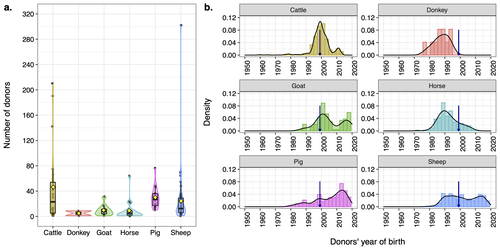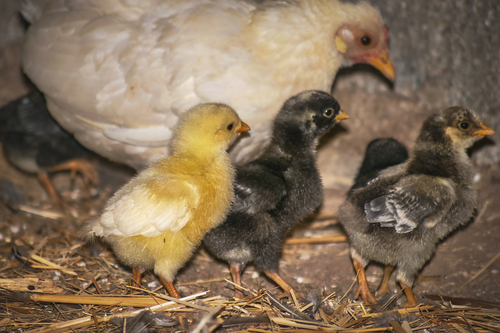Latest recommendations

| Id | Title | Authors | Abstract▲ | Picture | Thematic fields | Recommender | Reviewers | Submission date | |
|---|---|---|---|---|---|---|---|---|---|
05 Dec 2019
Effects of feeding treatment on growth rate and performance of primiparous Holstein dairy heifersYannick Le Cozler, Julien Jurquet, Nicolas Bedere https://doi.org/10.1101/760082Optimizing growth rate of dairy heifers through nutrition to maximize reproduction and productionRecommended by Luis Tedeschi based on reviews by Emilio Mauricio Ungerfeld and 2 anonymous reviewersThe idea of altering the growth rate of replacement heifers to improve reproductive and productive indicators of dairy cattle is not new. In the late 1970s, Gill and Allaire [1] indicated that the first parturition between 22.5 to 23.5 months of age yielded the optimum lifetime performance as long as the heifers had adequate body size [2]. Since 1980s, many studies have been conducted to understand the partitioning of energy between growth and lactation, including the impact of growth rates on the heifer puberty [3] as well as growth and development of the mammary gland [4,5]. The senior author of the recommended study has written previously about this research topic [6]. In the present manuscript, Le Cozler et al. studied the effect of feeding programs to increase the growth rate of late-born heifers to catch up with the growth of those born earlier in the calving season on their reproductive and productive performance. The authors analyzed 217 heifers for three consecutive years, split into three dietary treatments: control (C), accelerated growth rate from birth to 6 months of age (ID1), or accelerated growth rate from birth to 12 months of age (ID2). In this study, the late-born heifers receiving the ID2 treatment were able to partially reach the bodyweight of the early-born heifers at 24 months of age. In part, the incomplete understanding of the prioritization of the use of energy (and other nutrients) for different physiological stages (e.g., maintenance, growth, lactation, and pregnancy) of the dairy animal [7] undercuts the development of more robust feeding strategies to improve the reproductive and productive performance of the animal. In the recommended study by Le Cozler et al., although there was no impact on reproductive performance among groups, heifers in the group ID2 produced less milk (about 400 kg for the whole first lactation) than heifers in the groups C and ID1, apparently suggesting that energy allocation for growth had priority over that needed for lactation. The question then becomes what would have happened with energy partitioning if energy intake was restricted. Studies like this one are important to shed some light on the prioritization of the use of energy and other nutrients in support of growth, pregnancy, and lactation of dairy animals, and how compensatory growth differs between meat versus dairy growing animals, both physiologically and energetically. References [1] Gill, G. S., & Allaire, F. R. (1976). Relationship of Age at First Calving, Days Open, Days Dry, and Herdlife to a Profit function for Dairy Cattle1. Journal of Dairy Science, 59(6), 1131–1139. doi: 10.3168/jds.S0022-0302(76)84333-0 | Effects of feeding treatment on growth rate and performance of primiparous Holstein dairy heifers | Yannick Le Cozler, Julien Jurquet, Nicolas Bedere | <p>The objective of this study was to investigate effects of feeding-rearing programs that aim for first calving at 20-27 months (mo) of age on growth, reproduction and production performance of Holstein cows at nulliparous and primiparous stages.... | Cattle production, Reproduction, Ruminant nutrition | Luis Tedeschi | 2019-09-09 09:22:36 | View | ||
24 May 2022
Identifying cattle with superior growth feed efficiency through their natural 15N abundance and plasma urea concentration: a meta-analysis.Gonzalo Cantalapiedra-Hijar, Isabelle Morel, Bernard Sepchat, Céline Chantelauze, Gemma A. Miller, Carol-Anne Duthie, Isabelle Ortigues-Marty, Richard J. Dewhurst https://doi.org/10.5281/zenodo.578396015N as a marker for feed efficiency in beef cattleRecommended by Marcos Marcondes based on reviews by Emilio Mauricio Ungerfeld and 1 anonymous reviewerIdentifying individuals with a more remarkable feed efficiency may positively affect the profitability and sustainability of the beef industry (Cruz et al., 2010; Basarab et al., 2013). However, although most international nutrient requirements systems predict animal feed efficiency, intake data is usually unavailable at the farm level, and ranking animals based on efficiency might be challenging. In this sense, using differences in the occurrence of isotopic N between animal and diet (Δ15Nanimal-diet) might become a natural biomarker to determine feed efficiency at the farm level. This methodology was firstly demonstrated by Guarnido-Lopez et al. (2021). In the present study by Cantalapiedra-Hijar et al. (2022), the authors evaluated the extent to which Δ15Nanimal-diet can be used as a marker for feed efficiency in beef animals. For this, a meta-analysis was conducted using a database including 759 individual records for performance and N isotopic discrimination measured in plasma or muscle (Δ15Nanimal-diet; n = 749) and plasma urea concentration (n = 659). The database was composed of 37% Charolais, 15% Simmental, and 40% of beef crossbreds. The results confirmed that Δ15Nanimal-diet could discriminate animals with at least 0.10 kg/kg difference in feed efficiency. Furthermore, the Δ15Nanimal-diet marker also successfully discriminated the feed efficiency of two animals from the same contemporary group if they differ by at least 0.06 kg/kg of FCE. However, when trying to predict feed efficiency, using the two candidate biomarkers did not improve estimates. Lastly, when data from biomarkers were combined with performance data, improvement in the predictions was observed. Nonetheless, the present results warrant more studies to evaluate the use of Δ15Nanimal-diet as a biomarker for feed efficiency since it could be used not only for feed efficiency discrimination but also in genetic selections.
References Cantalapiedra-Hijar G, Morel I, Sepchat B, Chantelauze C, Miller GA, Duthie CA, Ortigues-Marty I, Dewhurst RJ (2022). Identifying cattle with superior growth feed efficiency through their natural 15N abundance and plasma urea concentration: A meta-analysis. Zenodo, 5783960, ver. 3 peer-reviewed and recommended by Peer community in Animal Science. https://doi.org/10.5281/zenodo.5783960. Cruz GD, Rodríguez-Sánchez JA, Oltjen JW, Sainz RD (2010). Performance, residual feed intake, digestibility, carcass traits, and profitability of Angus-Hereford steers housed in individual or group pens. J. Anim. Sci. 88:324-329. https://doi.org/10.2527/jas.2009-1932. Basarab JA, Beauchemin KA, Baron VS, Ominski KH, Guan LL, Miller SP, Crowley JJ (2013). Reducing GHG emissions through genetic improvement for feed efficiency: effects on economically important traits and enteric methane production. Animal 7:303-315. https://doi.org/10.1017/S1751731113000888. Guarnido-Lopez P, Ortigues-Marty I, Taussat S, Fossaert C, Renand G, Cantalapiedra-Hijar G (2021). Plasma proteins Δ15N vs. plasma urea as candidate biomarkers of between-animal variations of feed efficiency in beef cattle: Phenotypic and genetic evaluation. Animal 15:100318. https://doi.org/10.1016/j.animal.2021.100318.
| Identifying cattle with superior growth feed efficiency through their natural 15N abundance and plasma urea concentration: a meta-analysis. | Gonzalo Cantalapiedra-Hijar, Isabelle Morel, Bernard Sepchat, Céline Chantelauze, Gemma A. Miller, Carol-Anne Duthie, Isabelle Ortigues-Marty, Richard J. Dewhurst | <p>The objective of this study was to test two candidate biomarkers of feed efficiency in growing cattle. A database was built using performance data from 13 trials conducted with growing heifers, steers and young bulls and testing 34 dietary trea... | Physiology, Ruminant nutrition | Marcos Marcondes | 2021-12-07 15:24:15 | View | ||
31 Jul 2023

The big challenge for livestock genomics is to make sequence data payMartin Johnsson https://doi.org/10.48550/arXiv.2302.01140The price of sequencing the livestock genomicsRecommended by Marcin Pszczoła based on reviews by Mario Calus and 1 anonymous reviewerUsing sequence data in livestock genomics has often been regarded as a solution to revolutionize livestock breeding (Meuwissen & Goddard, 2010). The main expected benefits were to enhance the accuracy of breeding values, achieve better persistence of the accuracy over generations, and enable across populations or breed predictions (Hickey, 2013). Despite the promised benefits, whole-genome sequencing has not yet been implemented in livestock breeding programs, replacing SNP arrays for routine evaluation. In this work, Johnsson (2023) thoroughly reviewed the literature regarding the implications of whole-genome sequencing and functional genomics for livestock breeding practice. The author discusses the potential applications and reasons for difficulties in their implementation. The author speculates that the main challenge for making using the sequence data profitable is to overcome the problem of the small dimensionality of the genetic data and proposes three potential ways to achieve this goal. The first approach is better modeling of genomic segments, the second inclusion of undetected genetic variation, and the third use of functional genomic information. The paper presents an original and interesting perspective on the current status of the use of sequence data in livestock breeding programs and perspectives for the future. References Hickey,J.M.,2013.Sequencing millions of animals for genomic selection 2.0. Journal of Animal Breeding and Genetics 130:331–332. https://doi.org/10.1111/jbg.12054 Johnsson, M., 2023. The big challenge for livestock genomics is to make sequence data pay. arXiv, 2302.01140, ver. 4 peer-reviewed and recommended by Peer Community in Animal Science. https://doi.org/10.48550/arXiv.2302.01140 Meuwissen, T., Goddard, M.,2010. Accurate prediction of genetic values for complex traits by whole-genome resequencing. Genetics 185:623–631. https://doi.org/10.1534/genetics.110.116590
| The big challenge for livestock genomics is to make sequence data pay | Martin Johnsson | <p>This paper will argue that one of the biggest challenges for livestock genomics is to make whole-genome sequencing and functional genomics applicable to breeding practice. It discusses potential explanations for why it is so difficult to consis... |  | Genomics, Genomic selection | Marcin Pszczoła | 2023-02-03 08:08:39 | View | |
29 Jan 2024

Assessing the potential of germplasm collections for the management of genetic diversity: the case of the French National CryobankAlicia Jacques, Delphine Duclos, Coralie Danchin-Burge, Marie-Jose Mercat, Michele Tixier-Boichard, Gwendal Restoux https://doi.org/10.1101/2023.07.19.549644Exploring Genetic Diversity Management: Unveiling the Potential of Germplasm Collections in the French National CryobankRecommended by Yuliaxis Ramayo-Caldas based on reviews by Roy Costilla and 1 anonymous reviewerThe study by Jacques et al. (2024) addresses a critical concern in the context of genetic diversity erosion in domesticated animal populations. The research uses data from the cryopreserved resources from the French National Cryobank to manage genetic diversity in livestock species. The authors employ a comprehensive methodology to propose novel biodiversity metrics to characterize the status of genetic diversity of cryopreserved collections including cattle, sheep, goat, horse, donkey, and pig livestock species. The findings reveal significant variations of genetic diversity at species and breed levels. Breeds with a large commercial distribution had more donors in the collection than local breeds. The authors propose a practical framework for assessing germplasm collections, providing a valuable tool for planning and managing collections at both national and international levels. The study also highlights the usefulness of the Gini-Simpson and effective donor numbers indices to plan a more efficient sampling, whereas the index of diversity impact can be employed in the selection of the most suitable donors for immediate use, based on pedigree but also using genetic markers. In resume, this study makes a significant contribution to the field by offering a framework for the assessment of germplasm collections. Its innovative metrics provide insights that could guide strategic decision-making in planning, managing, and utilizing cryopreserved resources. This research is relevant and can benefit conservationists, and population genetics working towards the preservation and sustainable use of genetic resources in livestock species. Reference Jacques, A., Duclos, D., Danchin-Burge, C., Mercat, M. J., Tixier-Boichard M., Restoux, G. (2024). Assessing the potential of germplasm collections for the management of genetic diversity: the case of the French National Cryobank. bioRxiv 2023.07.19.549644. ver. 3 peer-reviewed and recommended by Peer Community in Animal Science. https://doi.org/10.1101/2023.07.19.549644
| Assessing the potential of germplasm collections for the management of genetic diversity: the case of the French National Cryobank | Alicia Jacques, Delphine Duclos, Coralie Danchin-Burge, Marie-Jose Mercat, Michele Tixier-Boichard, Gwendal Restoux | <p>Through a combination of selective pressure and genetic drift, there has been a notable erosion of genetic diversity in domesticated animal populations. In response, many countries, including France, have developed gene banks in order to conser... |  | Animal genetics | Yuliaxis Ramayo-Caldas | 2023-07-20 19:08:40 | View | |
15 Feb 2024

On-farm hatching and contact with adult hen post hatch induce sex-dependent effects on performance, health and robustness in broiler chickensL. A. Guilloteau, A. Bertin, S. Crochet, C. Bagnard, A. Hondelatte, L. Ravon, C. Schouler, K. Germain, A. Collin https://doi.org/10.1101/2023.05.17.541117The hen, the egg and the chick in conventional and on-farm hatching systemsRecommended by Florence Gondret based on reviews by Nicolas Bedere and Anna OlssonTo limit the use of antibiotics in the few days after hatching, it is necessary to improve the robustness of chicks during the early post-hatch period. This can be achieved by ensuring immediate access to feeds, optimizing the implantation and maturation of the microbiota and immune system of each chick, and minimizing exposure of stressors such as transportation. The study conducted by Guilloteau and colleagues (2024) compared the performance and health of chicks raised in conventional hatching systems with those raised in on-farm hatching systems. The authors showed that both systems yielded similar hatching percentage of eggs. Chicks from on-farm hatching systems exhibited higher body weights during the post-hatch period compared to those from conventional hatching, whereas health parameters were not affected by the system. An originality of the study was the examination of the benefits of the presence of an adult hen in hatching systems. The effects on chick traits were interpreted in relation to the hen behavior at hatching and a classification according to maternal or agonistic activities towards the chicks. However, the experimental design did not allow to make statistical correlations between hen behavior pattern and chick traits. Importantly, the presence of a hen decreased the hatching percentage, and this was likely associated with hen aggressiveness in the pen. The presence of the hen deteriorated the quality scores of the chicks in the on-farm hatching system, and increased mortality of chicks at hatching, negatively impacting chick weight gain and feed efficiency during the few days after hatching in both conventional and on-farm hatching systems. Thereafter, the effect of the presence of a hen on chick body weight was different according to the sex of the chicks and the type of hatching system. The presence of a hen did not reduce the parasitic load of the chicks nor improved clinical signs. No specific characterization of the fecal microbiota of the chicks was conducted, preventing the testing whether or not the presence of the hen affected the early implantation and maturation of the chick microbiome. Altogether, the data indicate that on-farm hatching systems are at least equivalent (in terms of health traits, feed efficiency) or even favorable (for faster growth in the early period after hatching) for chicks. Training the hens (considered as foster adults) to the presence of eggs and chicks or selecting hens according to specific activity behavioral patterns could be ways to establish better interactions between hens and chicks. Although the number and type of environmental stressors tested in the experiment differ from those in commercial farms, the article opens new perspectives for alternative hatching and farming practices. Reference Guilloteau LA, Bertin A, Crochet S, Bagnard C, Hondelatte A, Ravon L, Schouler C, Germain K, Collin A (2024) On-farm hatching and contact with adult hen post hatch induce sex-dependent effects on performance, health and robustness in broiler chickens. bioRxiv, 2023.05.17.541117. ver. 3 peer-reviewed and recommended by Peer Community in Animal Science. https://doi.org/10.1101/2023.05.17.541117.
| On-farm hatching and contact with adult hen post hatch induce sex-dependent effects on performance, health and robustness in broiler chickens | L. A. Guilloteau, A. Bertin, S. Crochet, C. Bagnard, A. Hondelatte, L. Ravon, C. Schouler, K. Germain, A. Collin | <p>To improve the early perinatal conditions of broiler chicks, alternative hatching systems have been developed. On-farm hatching (OFH) with an enriched microbial and stimulating environment by the presence of an adult hen is a promising solution... |  | Animal welfare, Farming systems, Poultry, Veterinary science | Florence Gondret | 2023-05-31 12:56:47 | View |
MANAGING BOARD
Karol B Barragán-Fonseca
Mohammed Gagaoua
Rachel Gervais
Florence Gondret
Francois Meurens
Rafael Muñoz-Tamayo
Anna Olsson
Seyed Abbas Rafat
Yuliaxis Ramayo-Caldas









